Corn – an incredible plant domesticated in North America thousands of years ago. Today, corn is not only consumed as food in nearly every country but is also used to produce alcohol, glue, plastic, plaster, industrial filters, and animal feed. Not just the kernels, but also the leaves, stalks, and husks are utilized.
Ripe corn kernels are rich in vitamins and minerals. While it's great to enjoy them year-round, keeping harvested cobs fresh isn’t easy. Once picked, the ears quickly lose their flavor and spoil. Today, we’ll explain how to store corn on the cob at home properly to maximize its shelf life.
Table of contents
Which Corn Is Suitable for Long-Term Storage
Preserving corn on the cob for winter is the optimal way to store this vegetable. This method helps keep the kernels sweet and flavorful. However, storing whole cobs requires significantly more space, especially with a large harvest.
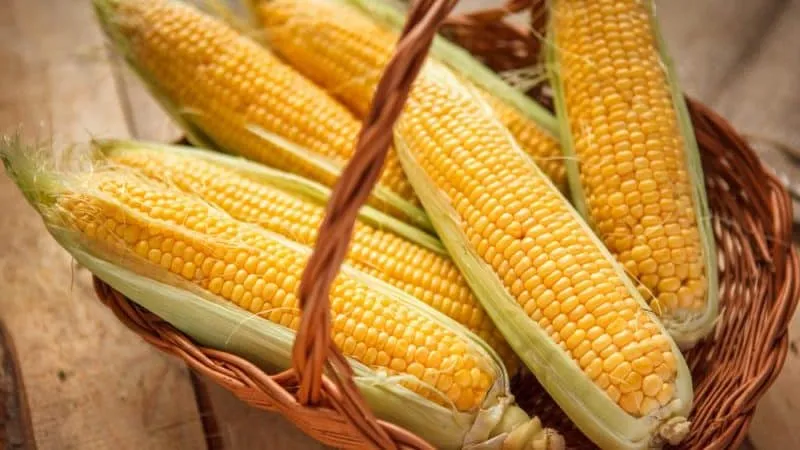 Late-season corn varieties are best for long-term storage. The kernels of these ears have a tough outer layer that helps preserve their quality.
Late-season corn varieties are best for long-term storage. The kernels of these ears have a tough outer layer that helps preserve their quality.
Interesting fact! On an industrial scale, corn is stored in the form of whole cobs. Even if processed in winter or spring the following year, they retain all their properties. The kernels are used to produce oil, molasses, starch, and flour.
If you cook such corn after several months of storage, it will taste almost the same as when freshly harvested, though slightly tougher and less sweet.
Storing Food-Grade vs. Feed-Grade Corn
Corn is categorized into food-grade and feed-grade varieties. Food-grade varieties have short, round ears with light beige kernels. These kernels are sweeter, tastier, and have a softer, juicier texture.
Feed-grade corn features large, elongated ears with bright yellow or orange kernels. These varieties are closer to their wild ancestors, with harder, denser kernels and a tough outer layer.
In industrial settings, harvested food-grade corn cobs are stored chilled for no more than 20 days (at temperatures around 0°C). At higher temperatures (+10°C), the kernels lose over 1.5% of their sugars daily, while at +25°C…+30°C, they lose up to half their sugars per day. After just two days, the product becomes unsuitable for consumption.
Feed-grade varieties have better shelf life. Well-prepared, sorted, disinfected, and chilled ears can be stored in specialized warehouses for several months.
How to Store Fresh Corn on the Cob
Storing fresh corn on the cob keeps the kernels juicier and more flavorful than storing loose kernels. Depending on the preservation method, the shelf life ranges from a few days to a year and a half. Freshly harvested raw ears can be stored at home in several ways.
Preparing the Corn
Before storing, the corn must be prepared.
Important! Do not wash corn intended for storage on the cob.
First, thoroughly remove the husks and silk from the ears. Discard any damaged ones. Then, place the ears in plastic bags and store them in the refrigerator’s vegetable compartment.
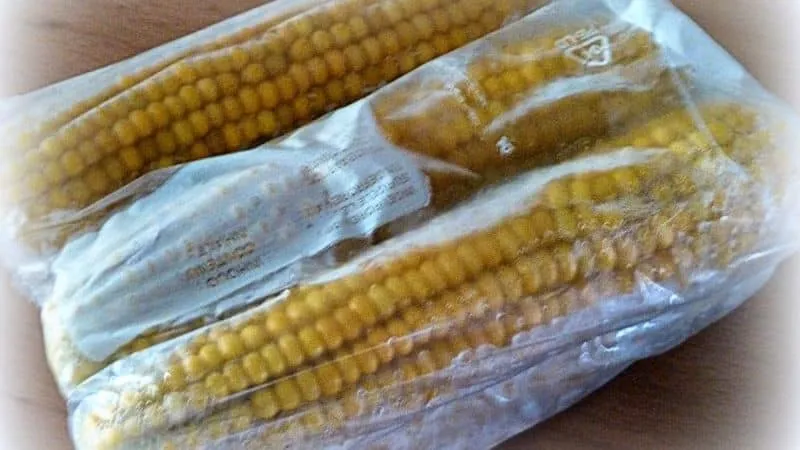
Storage Locations
Fresh ears should be kept in a cold, dark place, such as a refrigerator, cellar, or basement.
Corn meant for popcorn should not be refrigerated, as the kernels absorb moisture, softening the outer layer and reducing popping efficiency.
Storage Duration and Conditions
The shelf life of fresh corn at home depends on the initial quality of the product.
On average, ears last 5-7 days in the refrigerator. For the first three days, the kernels remain as sweet as freshly picked. Beyond that, the flavor deteriorates.
Other Ways to Preserve Corn on the Cob for Winter
Besides storing fresh, corn cobs can be canned, dried, or frozen. Let’s explore each method in detail.
Canning
Canning corn on the cob for winter is a unique and delicious way to preserve golden ears. Small ears (10-15 cm long) are ideal for canning and can be eaten whole. Choose young, sweet corn varieties with well-formed kernels.
Here are two simple recipes.
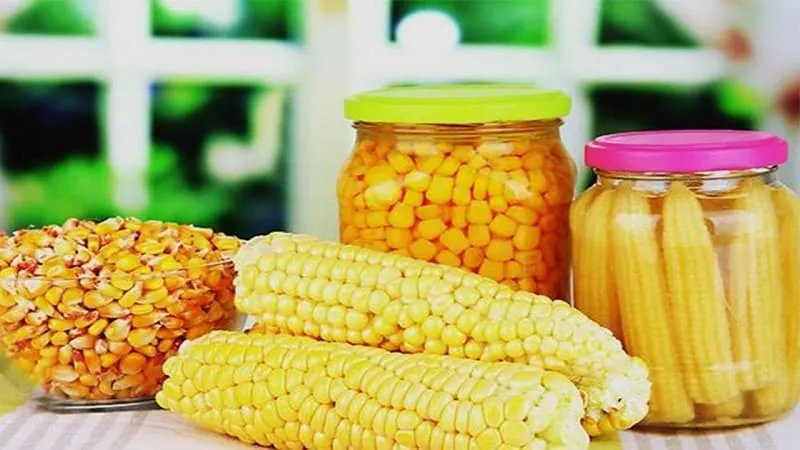
Salted Corn
This recipe requires only salt, water, and young corn cobs. Use 1 tbsp of salt (heaped) per liter of water.
Preparation:
- Boil the ears until tender and let them cool.
- Bring water to a boil, add salt, and cool.
- Place the corn vertically in sterilized jars and pour in the brine.
- Sterilize the jars in boiling water for 1-2 hours (depending on size).
- Seal the jars and let them cool.
Pickled Corn
For a tangier option, try this recipe with vinegar and spices. For a 1-liter jar, use 5-6 small ears, 1 tbsp each of salt and sugar, and 3 tbsp of vinegar (or citric acid as a substitute).
Preparation:
- Place cleaned ears in jars.
- Add salt, sugar, and vinegar to each jar.
- Fill with cold water.
- Sterilize in boiling water.
- Seal the jars and let them cool.
Drying
Another way to preserve tasty and nutritious ears for winter. Sort the ears, discarding damaged or moldy ones. Leave some husks on, only exposing the kernels slightly.
Hang prepared ears in a dry, dark place – individually, in pairs, or braided into clusters.
Dried corn is cooked the same way as fresh.
Freezing
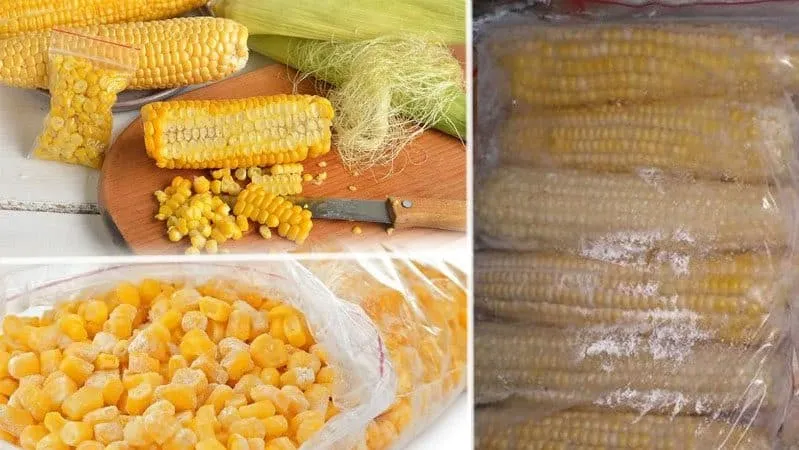
Freezing fresh corn on the cob is convenient. Remove husks and silk, then trim the ends to save freezer space.
Blanch the ears by boiling for 2 minutes, then plunge into ice water for 1-2 minutes. Dry thoroughly before wrapping in plastic or cling film and freezing. Frozen corn lasts up to 18 months without quality loss.
Storing Corn on the Cob at Home (Short-Term)
Unfortunately, delicious and nutritious corn doesn’t keep well. How long does a fresh ear last? At room temperature – no more than 10 hours. Refrigeration extends this to 5 days.
Important! Without freezing or canning, corn cannot be stored until the next harvest.
Refrigerated ears retain their sweet taste for the first three days, after which sugar breakdown makes them less flavorful.
Corn for popcorn shouldn’t be refrigerated, as moisture softens the hulls, reducing popping yield.
Before and After Cooking
Freshly picked ears should be husked and silk removed. Damaged kernels must be discarded. Store unwashed ears in plastic bags or containers in the fridge.
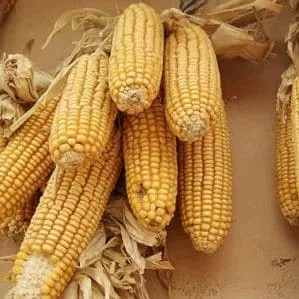
Cooked corn can also be stored. At room temperature, it lasts 10-12 hours.
In the fridge, wrap boiled ears in cling film or keep them in their cooking water. Cooked corn stays fresh for 2-3 days.
For longer storage, freeze boiled ears after cooling and drying. Wrap each in cling film and place in the freezer. Frozen corn keeps for months. Reheat by boiling for 10 minutes.
Tips and Recommendations
Two main reasons for reduced shelf life:
- Improper preparation (insufficient cleaning, dirty containers, etc.);
- Incorrect storage conditions (humidity above 15% or temperature above 4°C).
Follow these guidelines to extend shelf life:
- Thoroughly clean ears before storage.
- Use airtight packaging to slow spoilage.
- Sterilize jars for canning.
- Label frozen corn with dates to prioritize older stock.
- Use opened canned corn immediately to prevent spoilage.
Conclusion
Long-term storage of corn on the cob is only possible through canning or freezing. In the fridge, raw or cooked ears stay fresh for a few days. At room temperature, they last no more than 12 hours.







